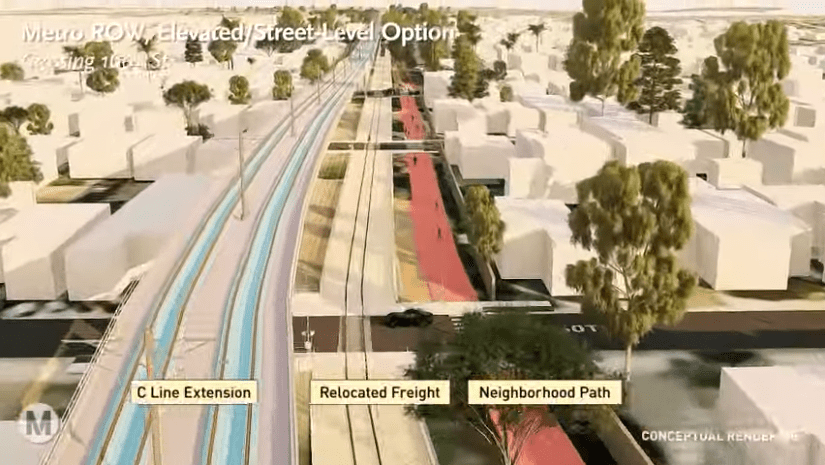 The energy-saving benefits of transit aren't limited to the transportation sector. Image: Jonathan Rose Companies via Richard Layman.
The energy-saving benefits of transit aren't limited to the transportation sector. Image: Jonathan Rose Companies via Richard Layman.At
a panel discussion yesterday at the Copenhagen climate summit, American
policymakers and transit experts delivered a clear message: Walkable
urban development must be part of any effective plan to reduce global
greenhouse gas emissions. Thanks to the magic of live webcasts, I can
relay a few highlights for Streetsblog readers.
Without
directing future development toward walkable urbanism, the climate
impacts of sprawl will overwhelm other efforts to curb greenhouse gas
emissions, said Robert Cervero, a professor specializing in
transportation and land use policy at UC Berkeley. "Urban development
patterns have a significant role to play in carbon reduction," Cervero
told the audience. "Otherwise we'll just get knocked back by land-use
patterns. Sustainable urbanism has to be part of the equation."
The
benefits of walkable development extend far beyond the efficiencies of
trains, buses, and bikes compared to cars. As journalist (and befuddling congestion pricing critic) David Owen has documented superbly, city dwellers use far less energy to, for instance, heat homes than suburbanites.
Cervero
attached some rough numbers to these "embedded energy savings." While
transit investment alone can achieve a 10 to 20 percent reduction in
America's per capita greenhouse gas emissions, he said, factoring in
the embedded energy savings of walkable development boosts that figure
to 30 percent. That's 30 percent compared to present-day emissions
levels. The reduction could reach as high as 60 percent, Cervero added,
compared to the level of per-capita emissions that would result from
continuing business-as-usual sprawl-inducing policies.
Since
most Americans aren't all that familiar with walkable urbanism, the
question of how to generate public support for more sustainable
development patterns inevitably arises. John Inglish of the Utah
Transit Authority shared some of the successes on this front from his
home state. It's a bit of an old story, but it's a good one: In the
late 1990s, the public-private venture Envision Utah began a campaign to shape regional growth in the Salt Lake City region. Through a series of public workshops, they built support for smart growth strategies that became state law in 1999.
How
did they do it? Inglish focused on the sheer fiscal common sense of
walkable urbanism. When presented with the fact that transit investment
produces huge savings in overall infrastructure costs, Utahns got on
board. By 2020, a transit-oriented growth scenario would save some $15
billion, which would otherwise go to roads, sewers, and other utilities
under the sprawling business-as-usual scenario. "That's more money for
schools and parks," Inglish said. "The community was not as
conservative when faced with the realities as had previously been
thought."
Unfortunately, the audio turned spotty during
Denver Mayor John Hickenlooper's turn at the podium. To substitute,
here's an excerpt from his interview with Democracy Now's Amy Goodman, in which the mayor marvels at Copenhagen's bike culture, visible even deep inside city hall:
MAYOR
JOHN HICKENLOOPER: ...here we are in Copenhagen. Thirty-seven percent
of the people in this city, when they go to work in the metropolitan
area, ride a bicycle to work. I mean, it’s remarkable. Their goal -- I
met yesterday for an hour with the deputy mayor of the environment and
transportation, Klaus Bondam, and Klaus Bondam described how their next
goal is to hit 50 percent. I mean, to have half your population, when
they go to work on bicycles, they’re healthier, the air is cleaner,
there’s less carbon emissions, you save money. I mean, the benefits are
dramatic, and you can see the difference just when you walk down the
street.
AMY GOODMAN: I mean, we were just in the city council
last night at like 10:30, 11:00. The whole bottom floor of this
century-old building is filled with not only bicycle racks, but
bicycles that fill them.
MAYOR JOHN HICKENLOOPER: Right.
AMY GOODMAN: And city council members, the guards, everyone are riding in and out of the city council on their bicycles.
MAYOR
JOHN HICKENLOOPER: Yeah. When I flew in, the fellow next to me on the
plane is a hotshot young technology expert, makes a huge amount of
money -- doesn’t own a car, rides his bike. You know, he says, “It’s
healthier. It’s more fashionable.” It’s -- you know, it’s what his
friends do. And I think that’s the whole thing that -- when you get to
public sentiment, I mean, what Lincoln was talking about. We need to
change our public sentiment so people want to do these things. And it’s
not government coming down and being punitive, but it’s creating a
change, a transformation in our attitudes.






